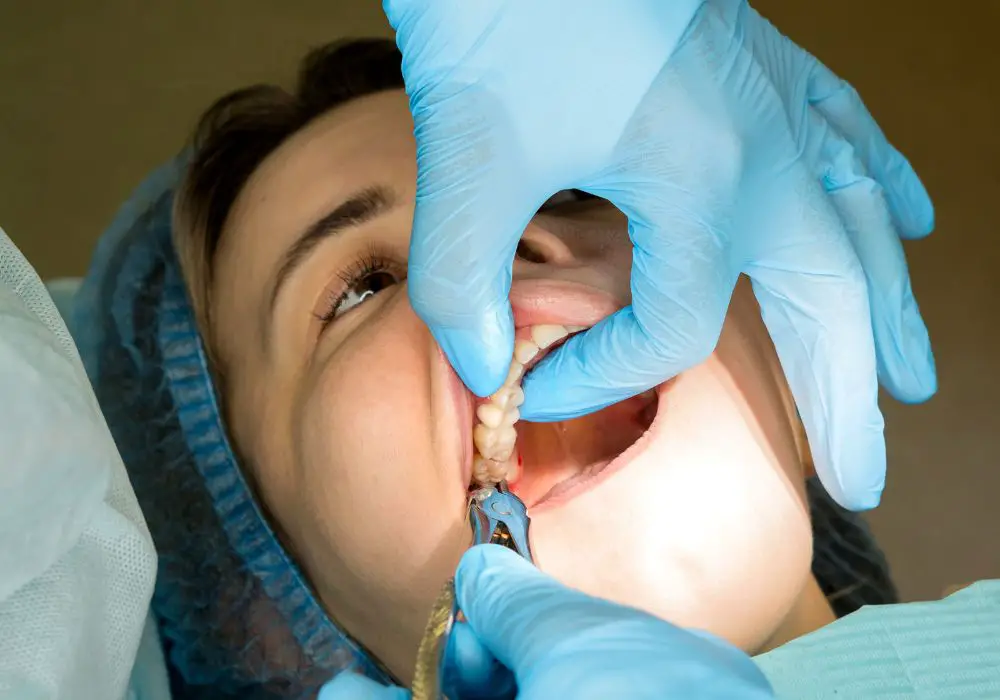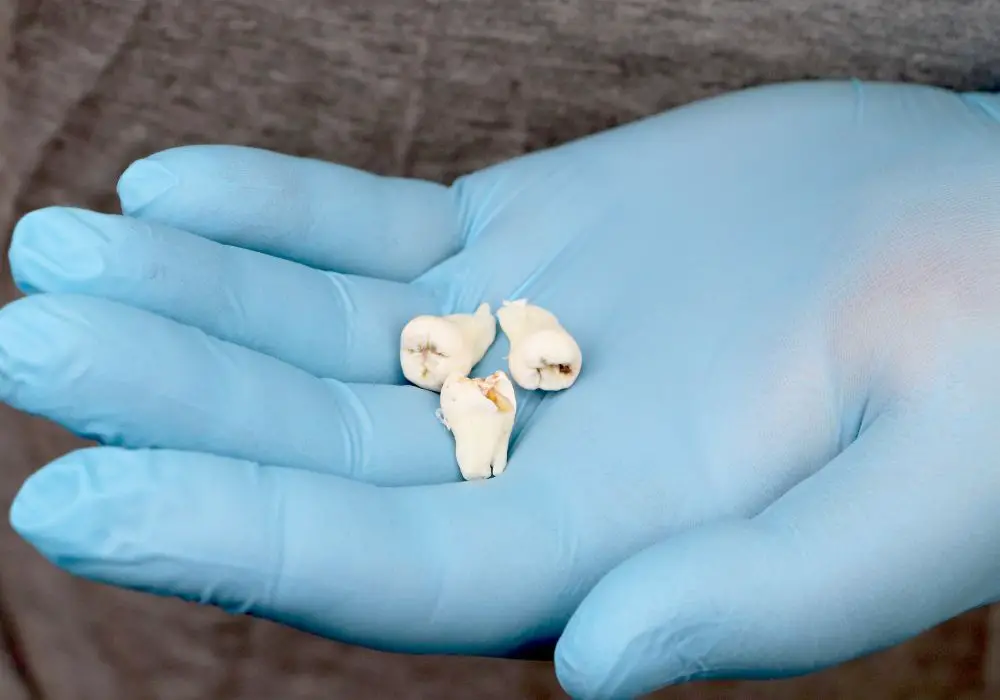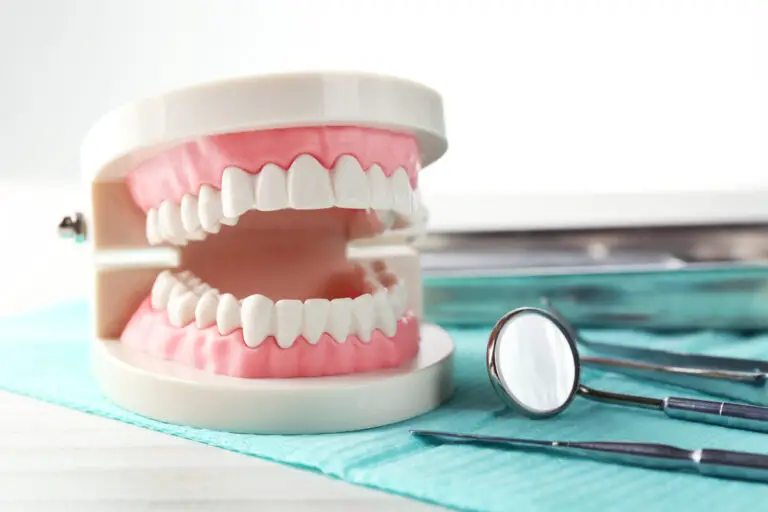Are you dreading the thought of getting your wisdom teeth removed? You may be wondering if it’s possible to have the procedure done without anesthesia. While it’s true that some dentists may be able to remove an exposed wisdom tooth without anesthesia, it’s important to understand the risks and limitations of this option.
Anesthesia is typically used during wisdom tooth extraction to minimize pain and discomfort. However, some people may have concerns about the safety and potential side effects of anesthesia. In some cases, a dentist may be able to remove an exposed wisdom tooth without anesthesia, but this may not be possible for all patients. It’s important to discuss your options with your dentist and weigh the pros and cons before making a decision.
Understanding Wisdom Teeth

Wisdom teeth, also known as third molars, are the last set of teeth to emerge in your mouth, typically between the ages of 17 and 25. Most people have four wisdom teeth, one in each corner of their mouth. However, some people may have fewer or none at all.
Wisdom teeth can cause problems if there isn’t enough room for them to grow properly. They may emerge at an angle, partially emerge, or become impacted, which means they are stuck below the gum line and cannot emerge fully. This can lead to a variety of issues, such as:
- Pain and discomfort
- Infection
- Damage to adjacent teeth
- Crowding of other teeth
- Formation of cysts or tumors
If you experience any of these symptoms, your dentist may recommend removing your wisdom teeth.
It’s important to note that not everyone needs to have their wisdom teeth removed. If your wisdom teeth are healthy, fully erupted, positioned correctly, and can be cleaned as part of your daily hygiene practices, you may be able to keep them. Your dentist will evaluate your specific situation and make a recommendation based on your individual needs.
In the next section, we’ll explore whether it’s possible to remove wisdom teeth without anesthesia.
The Role of Anesthesia in Dental Procedures
When it comes to dental procedures, anesthesia plays a crucial role in ensuring that patients remain comfortable and pain-free during the procedure. Anesthesia is a medical treatment that is used to prevent pain or discomfort during a surgical or dental procedure. It can be administered in different ways, depending on the type of procedure and the patient’s medical history.
There are different types of anesthesia that can be used during dental procedures. The type of anesthesia used will depend on the complexity of the procedure, the patient’s medical history, and their level of anxiety. Here are some of the most common types of anesthesia used in dental procedures:
- Local anesthesia: This type of anesthesia is used to numb a specific area of the mouth where the procedure will be performed. It is administered through an injection and is typically used for minor procedures, such as filling a cavity or extracting a single tooth.
- Nitrous oxide: Also known as laughing gas, nitrous oxide is a type of minimal sedation that is used to help patients relax during a dental procedure. It is administered through a mask that fits over the nose and is typically used for minor procedures.
- General anesthesia: This type of anesthesia is used to put the patient to sleep during the procedure. It is typically used for more complex procedures, such as wisdom teeth removal or jaw surgery.
It is important to note that the use of anesthesia in dental procedures is generally safe when administered by a qualified and experienced dental professional. However, it is important for patients to disclose their full medical history and any medications they are taking to their dental provider to ensure that the appropriate type and dose of anesthesia is used.
In conclusion, the use of anesthesia in dental procedures plays a crucial role in ensuring patient comfort and safety during the procedure. The type of anesthesia used will depend on the complexity of the procedure, the patient’s medical history, and their level of anxiety. It is important for patients to communicate openly with their dental provider to ensure that the appropriate type and dose of anesthesia is used.
Can a Dentist Remove Wisdom Teeth Without Anesthesia?
If you are scheduled to have your wisdom teeth removed, you may be wondering if it is possible to have the procedure done without anesthesia. While it is technically possible, it is not recommended for several reasons. In this section, we will explore the realities of pain management during wisdom tooth removal and alternative methods to anesthesia.
The Reality of Pain Management
Wisdom tooth removal is a surgical procedure that involves cutting through gum tissue and removing bone. As a result, it can be quite painful. While some people have a high pain tolerance and may be able to tolerate the procedure without anesthesia, most people will experience significant discomfort.
Additionally, even if you think you can handle the pain, it is important to remember that your body’s natural response to pain is to tense up. This can make the procedure more difficult for your dentist and increase the risk of complications.
Alternative Methods to Anesthesia
If you are concerned about the risks associated with anesthesia, there are alternative methods of pain management that your dentist may be able to offer. These include:
- Local anesthesia: This involves numbing the area around the tooth with an injection. While you will still be awake during the procedure, you should not feel any pain.
- Nitrous oxide: Also known as laughing gas, this can help you relax during the procedure and reduce your perception of pain.
- Oral sedation: This involves taking a pill before the procedure that will make you feel drowsy and relaxed. While you will still be awake, you may not remember much of the procedure.
It is important to talk to your dentist about your concerns and explore all of your options before deciding on a pain management strategy. Ultimately, the most important thing is to ensure that you are comfortable and safe during the procedure.
Risks and Benefits

When it comes to wisdom teeth removal, anesthesia is usually recommended to ensure the patient’s comfort during the procedure. However, some people may prefer to have their wisdom teeth removed without anesthesia due to personal reasons or concerns about the risks associated with anesthesia. In this section, we will explore the risks and benefits of having your wisdom teeth removed without anesthesia.
Risks
Removing wisdom teeth without anesthesia can be a painful and uncomfortable experience. The procedure involves cutting through gum tissue and bone to access the tooth, which can cause significant pain and discomfort. Additionally, without anesthesia, patients may experience anxiety and stress during the procedure, which can make it more difficult for the dentist to perform the extraction.
Another risk of having your wisdom teeth removed without anesthesia is the potential for complications during the procedure. Without anesthesia, patients may move or flinch during the extraction, which can increase the risk of injury to surrounding tissues and nerves. Additionally, the dentist may need to use more force to remove the tooth, which can increase the risk of damage to the tooth or surrounding structures.
Benefits
One of the main benefits of having your wisdom teeth removed without anesthesia is the reduced cost of the procedure. Anesthesia can be expensive, and removing wisdom teeth without it can save patients a significant amount of money. Additionally, without anesthesia, patients can avoid the risks associated with anesthesia, such as allergic reactions, nausea, and vomiting.
Another benefit of having your wisdom teeth removed without anesthesia is the reduced recovery time. Anesthesia can cause drowsiness and fatigue, which can prolong the recovery period. Without anesthesia, patients can recover more quickly and return to their normal activities sooner.
In summary, while it is possible to have your wisdom teeth removed without anesthesia, it is important to consider the risks and benefits before making a decision. While avoiding anesthesia can save money and reduce recovery time, it can also increase the risk of pain, discomfort, and complications during the procedure. It is recommended that patients discuss their options with their dentist to determine the best course of action for their individual needs and preferences.
Patient’s Rights and Choices
When it comes to dental procedures, patients have certain rights and choices that they should be aware of. Here are some of the most important ones to keep in mind when considering wisdom tooth extraction without anesthesia:
Patient’s Rights:
- To be fully informed about the procedure and its risks and benefits
- To ask questions and receive clear answers from the dentist
- To refuse treatment or request a second opinion
- To receive treatment in a safe and clean environment
- To have their privacy respected during the procedure
Patient’s Choices:
- Choice of anesthesia: While some patients may prefer to have anesthesia during the procedure, others may choose to have it done without anesthesia. It is important to discuss this with your dentist and weigh the pros and cons of each option.
- Choice of dentist: Patients have the right to choose the dentist who will perform the procedure. It is important to find a dentist who is experienced in wisdom tooth extraction and who makes you feel comfortable.
- Choice of aftercare: Patients should be given clear instructions on how to care for their mouth after the procedure. This may include pain management options and dietary restrictions.
Remember, it is important to communicate with your dentist and make informed decisions about your dental care. By knowing your rights and choices, you can feel more confident and comfortable during the wisdom tooth extraction process.
Preparation for Wisdom Teeth Removal Without Anesthesia
If you’re planning to have your wisdom teeth removed without anesthesia, there are a few things you can do to prepare yourself for the procedure. Here are some tips to help you feel more comfortable and confident during the process:
- Plan for transportation: Since you won’t be under anesthesia, you’ll be able to drive yourself home after the procedure. However, it’s still a good idea to arrange for someone to drive you to and from the dentist’s office, as you may feel a bit groggy or disoriented after the procedure.
- Eat beforehand: It’s important to have a full meal before your appointment, as you won’t be able to eat for a few hours after the procedure. Choose something light and easy to digest, such as soup or a sandwich.
- Ask questions: Don’t be afraid to ask your dentist any questions you may have about the procedure. They will be happy to explain the process to you and answer any concerns you may have.
- Take pain medication: Since you won’t be under anesthesia, you may experience some discomfort during the procedure. Taking an over-the-counter pain medication such as ibuprofen or acetaminophen before your appointment can help reduce any pain or discomfort.
- Relax: It’s normal to feel a bit nervous before any dental procedure, but try to relax as much as possible. Take some deep breaths, listen to calming music, or practice meditation or visualization techniques to help ease your anxiety.
By following these tips, you can help ensure that your wisdom teeth removal without anesthesia goes smoothly and with minimal discomfort.
Post-Procedure Care

After your wisdom teeth removal, it’s crucial to take good care of your mouth to ensure proper healing. Here are some tips to help you take care of yourself after the procedure:
- Bite down gently on the gauze pad placed over the extraction site to help stop the bleeding. Change the gauze pad every 30-45 minutes or as needed.
- Apply ice packs to your cheeks for the first 24-48 hours to help reduce swelling. Apply the ice pack for 20 minutes at a time and then remove it for 20 minutes.
- Rest and avoid any physical activity for the first few days after the procedure.
- Avoid smoking and using straws for at least 24 hours after the procedure, as these actions can dislodge the blood clot and delay healing.
- Eat soft foods like soup, yogurt, or mashed potatoes for the first few days after the procedure. Avoid hot, spicy, or crunchy foods that can irritate the extraction site.
- Brush your teeth gently, but avoid the extraction site for the first few days. Rinse your mouth with saltwater after meals to help keep the area clean.
- Take pain medication as prescribed by your dentist to help manage any discomfort.
- If you experience any unusual symptoms like fever, severe pain, or excessive bleeding, contact your dentist immediately.
Remember that everyone’s recovery process is different, so be patient with yourself and follow your dentist’s instructions carefully. With proper care, you can ensure a smooth and successful recovery after your wisdom teeth removal.
Frequently Asked Questions
What are the options for anesthesia during wisdom teeth removal?
There are three types of anesthesia options for wisdom teeth removal: general anesthesia, conscious sedation, and local anesthesia. Your dentist or oral surgeon will discuss which option is best for you based on your individual needs.
Can wisdom teeth be removed without sedation?
Yes, wisdom teeth can be removed with only local anesthesia. However, this option may not be recommended for everyone. Your dentist or oral surgeon will determine if local anesthesia is appropriate for your situation.
What is conscious sedation and how does it work?
Conscious sedation is a type of anesthesia that allows you to remain awake during the procedure, but you will feel relaxed and drowsy. The medication is given through an IV, and you will be monitored throughout the procedure to ensure your safety.
Is it safe to have wisdom teeth removed with only local anesthesia?
Yes, having wisdom teeth removed with only local anesthesia is generally safe. However, it may not be the best option for everyone. Your dentist or oral surgeon will discuss the risks and benefits with you and determine if local anesthesia is appropriate for your situation.
Do I need someone to stay with me after wisdom teeth removal?
Yes, it is recommended that you have someone stay with you for a few hours after the procedure. The anesthesia and pain medication can make you drowsy and impair your judgment, so it is not safe to drive or operate heavy machinery.
How do dentists manage pain during wisdom teeth removal?
Dentists typically manage pain during wisdom teeth removal with a combination of anesthesia and pain medication. Your dentist or oral surgeon will discuss the best pain management plan for you based on your individual needs.







